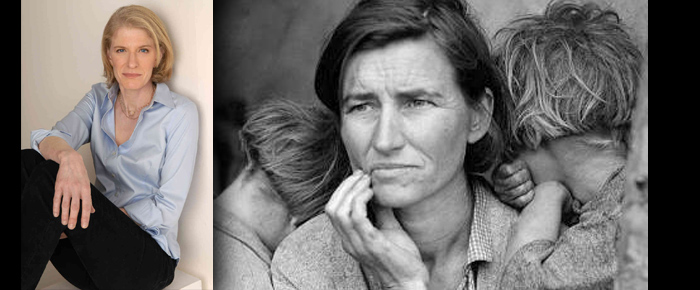
By Heidi Simmons
—–
Mary Coin
By Marisa Silver
Fiction
—–
The iconic image of Dorothea Lange’s Depression Era photo “Migrant Mother” is the inspiration for Marisa Silver’s new novel, Mary Coin (Blue Rider Press, 324 pages.) The public domain photo, a concerned and desperate mother and her children, is colorized for the cover. Beautiful and intriguing, the picture reflects the nature of the prose inside.
“I didn’t know anything about the photo,” said Silver at the season opening of the UCR Palm Desert Arts and Letters Series. “I knew the image and I was compelled to write what was around the edges.”
Dorothea Lange worked for the U.S. Government’s Works Progress Administration during the Great Depression. As a photographer, her job was to travel the country and document the lives of Americans and send back an accurate “picture” of their conditions. Florence Thompson, the mother of seven children, is featured in the famous photograph. Silver fictionalizes these two women.
“I imagined their lives from both sides of the camera,” said Silver. “Using the framework of the real women — not just about their lives, but how history is seen and remembered.”
Dividing the narrative into three distinct stories, Silver writes about Mary Coin, the woman in the photo; Vera Dare, the photographer; and Walker Dodge, a present day professor of history.
The journey begins with Mary Coin, a young and hopeful girl in Oklahoma. Silver follows the fictional Coin across the country as she matures and struggles to care for her children and find work. Coin eventually arrives in California where she inadvertently becomes the subject of the photo.
Dare, the photographer, simultaneously travels across the country. Although she is paid to take photos, Dare has personal struggles she too must overcome. Dare and Coin intersect in California’s Central Valley.
The present day character, Dodge, is searching to understand his family history and discovers he is linked to Mary Coin, the woman in the photo. Crisscrossing the three characters, the reader waits to see how their lives impact one another.
Richly textured and beautifully rendered, the women characters in Mary Coin are powerful and intense. Each is the antithesis of the other, but they are both survivors, desperate to make it through the Depression.
The world Coin and Dare share is certainly the most fascinating and interesting aspect of the book. Dodge’s story is not nearly as compelling. Silver gives the reader a glimpse into the 1930s and the challenges of being a woman. Some of the challenges for women never change.
“I’m curious to know what is a documented image?” said Silver. “Can you capture reality and preserve history?” This is what Silver attempts to do with her story. She has written these women into a historical novel and given them life.
Silver comes from a family of filmmakers. She has directed four Hollywood films herself. She is best known for the movie He Said, She Said. “The more films I made, the further I got away from the story,” said Silver. “I’d ask myself, ‘What am I making this film about?’ I liked telling stories. I was just telling them in the wrong medium.” Silver left the film business to pursue creative writing full-time.
“Sometimes I think I am a collagist,” said Silver. “I’m putting little stories together to form a bigger resonance.” In Mary Coin, Silver manages to beautifully portray the female characters but the ultimate picture is slightly out-of-focus.












































